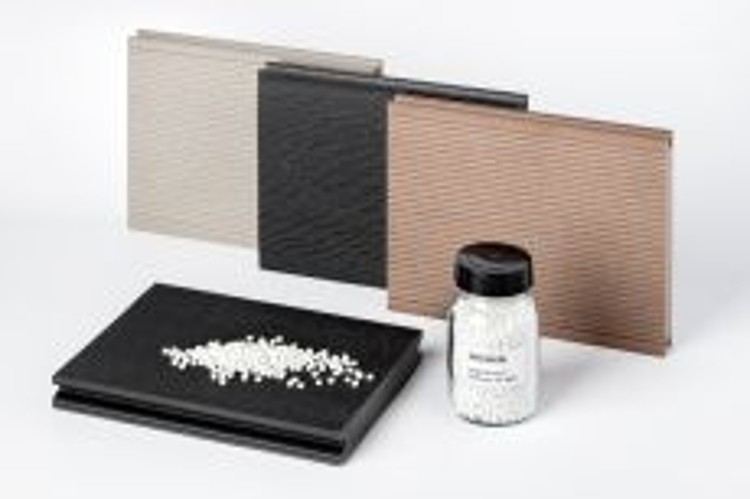New Silicone Additive by WACKER Improves Manufacture of Wood-Plastic Composites
Munich, Oct 19, 2016
WACKER, the Munich-based chemical group, will be showcasing new thermoplastic silicone additives for the more efficient manufacture of wood-plastic composites (WPC) at the 20th International Trade Fair for Plastics and Rubber K 2016. GENIOPLAST® Additive for WPC improves processing when extruding plastic blends that contain wood, thereby making the manufacture more cost effective and less energy intensive. The additives also enhance the mechanical properties and water-repellency of such plastics. As a result of their weathering resistance and robustness, wood-plastic composites are increasingly in demand in the construction, automotive, and furniture industries. K 2016 takes place in Düsseldorf, Germany, from October 19 to 26, 2016.

Two years ago, in collaboration with the Wood Competence Center in Linz, Austria, WACKER started developing new processing aids for wood-polymer materials. These wood-plastic composites consist of about 50 to 75 percent refined wood fibers and up to 25 to 50 percent of a polymer such as polyethylene, polypropylene or polyvinyl chloride. The composites look similar to wood materials and have a similar feel. Thanks also to their durability and processing flexibility, they present an attractive alternative to normal plastics or wood for the construction, furniture and automotive industries.
To enable the wood-polymer components to bond optimally to each other in extrusion molding and to keep the resistance in the extrusion process as low as possible, additives are incorporated as lubricants. By developing the new GENIOPLAST® Additive for wood-plastic composites, WACKER can now offer highly effective processing aids, whose many positive properties give them a competitive edge over comparable products.
The new additives contain a thermoplastic silicone elastomer. In comparison with conventional silicones, which cure irreversibly following vulcanization, thermoplastic silicones behave thermoplastic also within a certain range of temperatures. This makes them ideally suited as processing aids for thermoplastics with organic fillers.
GENIOPLAST® Additive for Wood-Plastic Composites primarily acts as a lubricant. It reduces the coefficient of friction of the plastic and thereby the internal and external friction during extrusion. This enables the processes to run more stably and efficiently and save more energy. Tests show that one percent of the additive results in a significantly higher throughput – depending on the plastic blend and extruder used of up to 65 percent. This, in turn, leads to lower unit costs in production.
The additives are also highly effective: even one percent is sufficient to achieve good lubricating properties. In comparison, conventional lubricants require WPC manufacturers to use between two and six percent of additive to achieve the same effect during extrusion.
GENIOPLAST® Additive for WPC can be blended easily as the thermoplastic silicone elastomer is already premixed with the corresponding plastic. This preformulated ready-to-use mixture enables the lubricant to be optimally integrated in the production process. At present, formulations with polypropylene (GENIOPLAST® PP 20A08) and polyethylene (GENIOPLAST® HDPE 20A03) are available.
GENIOPLAST® Additive for Wood-Plastic Composites not only improves the production process, but also the properties of the end product. Wood-based plastics manufactured with the new processing aid have higher impact strength and flexural toughness than parts mixed with standard additives. GENIOPLAST® PP 20A08 and GENIOPLAST® HDPE 20A03 also reduce water absorption. As a result, the end products are significantly more resistant to weathering.
Wood-plastic composites are currently right on trend. They combine the positive properties of the natural product wood with the benefits of plastics. Whether they are used for decking boards, siding, fencing, windows, doors, furniture, parts for vehicle interiors or technical components – there is now a huge range to choose from. Thanks to their resistance and processing flexibility, wood-plastic materials offer an attractive alternative to unreinforced plastics for the construction, furniture and automotive industry. Wood-based plastics can be machined using all common woodworking machinery and can be worked with a great deal of freedom of design.
Visit WACKER at K 2016 in Hall 6, Booth A10.
Press Picture
GENIOPLAST® - Wood Plastic Composites (WPC)
At the International Trade Fair for Plastics and Rubber, K 2016, the Munich-based chemical group, WACKER, will be showcasing new additives for the manufacture of wood-based plastics, so-called wood-plastic composites (WPC).
Download picture (JPG, 44 KB)




